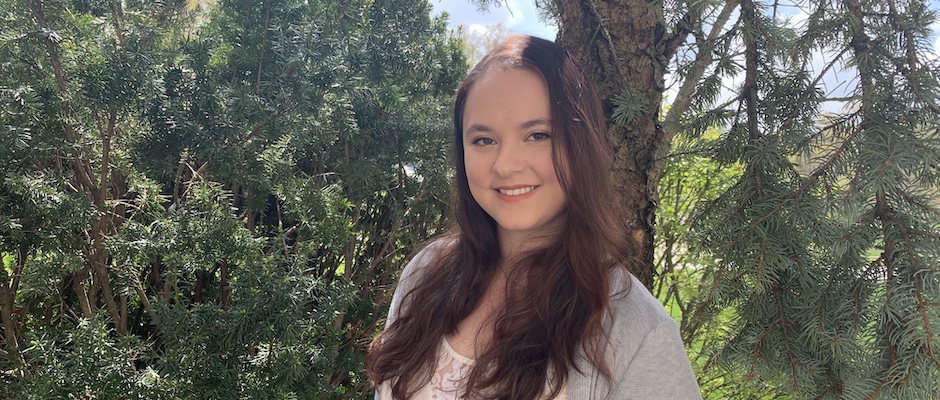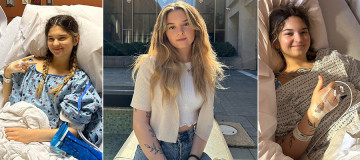
“It can’t be endometriosis,” the gynecologist said, her voice steady and certain, to the mother of the 15-year-old girl. Her mom had asked if her daughter could have endometriosis, and the gynecologist had answered with a tinge of laughter at the absurdity of the question. “She’s too young to even have endometriosis.”
I didn’t know it then, but that exchange at the doctor’s office was the beginning of my endo story. I’d been having period pain and issues long before I was 15, but 15 was when I first started experiencing some excruciating symptoms that made it almost impossible for me to ignore that my periods were causing a problem. (Think: vomiting up the ibuprofen that was meant to help me after my cramps woke me up at three in the morning, followed by passing out.) When I, an insecure and anxious teenager, gathered up the strength to see a specialist about it, my mom’s concern over whether I could have endometriosis was immediately brushed off. I was put on birth control for dysmenorrhea (the fancy medical term for “painful periods”) and sent on my not-so-merry way.
What 15 year old, already nervous and naive, would question a professional? I certainly didn’t. And it took me many rounds of professionals—and years of treatment, from birth control pills to antidepressants—to start questioning that maybe doctors could get things wrong.
I didn’t think of myself as an advocate back then. I thought of myself as the quiet type of patient who sat in a room and absorbed everything a doctor threw at me like a sponge, thanking them for their help and returning home with a feeling that my life was on some kind of track. Like the doctor had just handed me a guidebook for how to manage my body and its chronic pain and symptoms, and we would have it all figured out now. I put every doctor on a pedestal and saw each one as some kind of impeccable character, a being of unimaginable power, instead of who they really were: flawed humans with an intention to help, working in a field riddled with misunderstandings, misdiagnoses, and lagging research.
My questioning of the medical field, and what really started my advocacy for my body and medical treatment, began when I was 19, four years after this story began. I entered an appointment with concerns about unrelenting daytime fatigue and pelvic pain and left the same appointment with a prescription for an antidepressant. What did an antidepressant have to do with my pelvic pain? Apparently, all that mattered was that I was young, a college student, and tired, so therefore I was stressed, anxious, and possibly depressed: in need of antidepressants, not pain meds or speciality referrals.
Due to my unrelenting opinion of not being allowed to question a doctor’s prescription, I took the antidepressants and did feel my anxiety get relieved. But it did absolutely nothing for my fatigue or pain. Despite that observation, a seed of “is this all in my head?” had already been planted, watered and rooted. There would be no turning back from the doubt inside that somehow, someway, my brain was tricking itself and my body into feeling the way that it did.
Then, after multiple instances of falling asleep in class, I realized enough was enough, rolled up my sleeves and marched to my doctor for some referrals. Endocrinology. Gastroenterology. Sleep medicine. None of them were gynecology. I began to feel increasingly more hopeless: what was wrong with me, and why couldn’t the doctors find anything? Was I really just making it all up? My first investigation that I instigated myself failed, feeding my insecurity rather than helping it.
After graduating college, and after months of experiencing increasing abdominal pain and digestive issues that flared around my period, my mom brought up the endometriosis idea again. The thought had never occurred to me because no specialist, let alone a young twenty-something with no medical training, had made the connection that maybe my uterus was involved.
Then, at age 22, I started my second investigation into my health that required perseverance and personal strength. As I waded into the OB/GYN pool, I shoved my history from age 15 aside and asked, “Is it possible that I have endometriosis?” It was a question that I promptly brought up during a regular checkup that I needed with a gynecologist, since pap smears had just become a relevant piece of preventative care in my life. (Get your paps, people!) She said that it was possible, but she wasn’t as familiar with the surgery that would be required to diagnose endometriosis like some other specialists were. So she advised me to try pelvic floor physical therapy first and to get an ultrasound to check that everything was “normal” before referring me to an endometriosis specialist.
To sum up the months that I spent in physical therapy (and my ultrasound results which ended up normal), I did have some pelvic floor dysfunction like many other people with endometriosis do. But treating it didn’t get rid of many of my worst symptoms, like my fatigue and cramping, so the referral for a specialist came, and I was scheduled for laparoscopic surgery near the end of the year, right before Thanksgiving.
To say I was nervous was an understatement on my end. I don’t know why anyone wouldn’t be nervous to have surgery, but for me, it was my first surgery, and I was a wrack of anxiety also in need of answers. Once the IV was in, I wiped away some anxious tears before they put me on the operating table, and the next thing I remembered was waking up in the recovery room.
The first thing I asked when I was awake, as my hand almost grabbed the surgical resident near me in desperation, was “did they find anything?” And when she said, “There was some endometriosis, but don’t worry, it was minimal and we took care of it,” I sighed in relief. Not because I had endometriosis, but because I wasn’t crazy. What I had was real, and I finally had a name for the enemy, the cause of all of my years of intensifying concerns. When your gut feeling about your health problems is confirmed, there is something victorious about it, even if it does come with the bad news of having a chronic, incurable illness.
If I’ve learned anything from my endometriosis journey—from my symptoms that started with bad cramps and vomiting, to seeking out help at age 15, to getting surgery at age 22—it’s that the amount of disease in your body has nothing to do with how you experience it, and that it’s more than just a menstrual condition. I had very little endometriosis removed via excision surgery, yet it caused me debilitating symptoms of chronic fatigue, abdominal pain, GI distress, and more—even when I wasn’t on my period. It’s a disease not unlike an invasive growth, wreaking havoc in places where it’s not meant to be, growing in places where it’s not supposed to grow. If I were to leave one message from my story, it would be this: your pain is real. Even if endometriosis can’t be seen through an X-ray or an ultrasound (like how mine was missed by all of the imaging and scans), it’s still there, and the pain is not imagined.
For seven years, I was silenced. Gaslit and made to believe my pain was all in my head. But over a year after receiving the diagnosis that confirmed those confusing seven years as something not just a figment of my imagination, I can also say this with confidence: for seven years, I was built to be stronger. More resilient. A fighter. And mostly importantly, an advocate for myself and for those who struggle with endometriosis and invisible conditions alike.
Samantha Chrin has been writing for as long as she can remember. Raised between Orlando, Florida and Cleveland, Ohio, she earned a Bachelor of Science degree in Chemistry from Case Western Reserve University. During her four years there, she persevered through worsening endo symptoms and wasn’t diagnosed until shortly after graduation. She’s currently working in the informal science education field, but will be starting on the PhD path to becoming a medicinal chemist to develop better treatments for chronic diseases. When she’s not writing or in the lab, she’s devouring books, baking from scratch, painting (by numbers, of course), and binge-watching episodes of Buffy the Vampire Slayer. She’s also started a new blog, currently in the works as The Spoonie Diaries, to share stories, advocate for awareness, and break stigma around mental and chronic illnesses. You can follow her on Instagram @samthespoonie.
Editor's note: Would you like to contribute to EndoStories? Click here to learn how to submit your work.
*Patient stories submitted to EndoFound.org are the views of the patient and not necessarily those of the foundation. All testimonials are from real patients, and may not reflect the typical patient’s experience, and are not intended to represent or guarantee that anyone will achieve the same or similar results.









